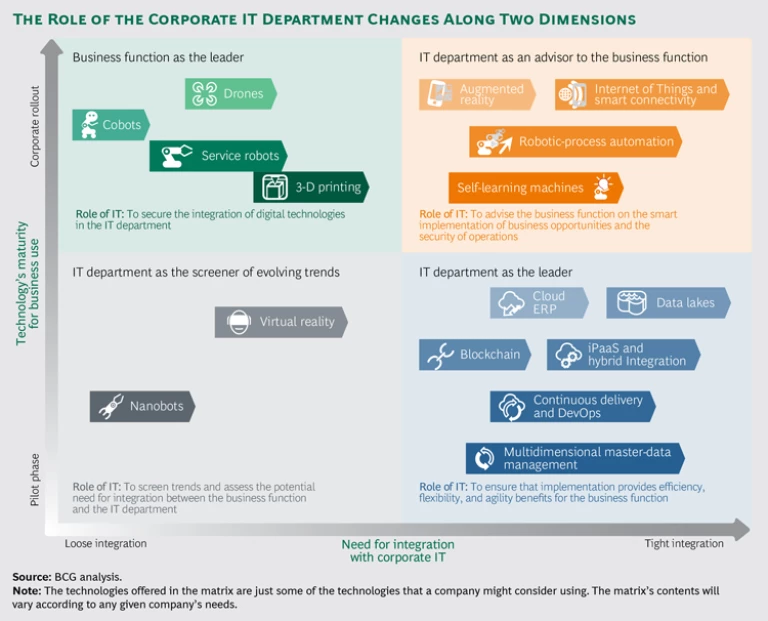Digital technologies continue to rapidly reshape the business landscape. (See the appendix, “Technology Trends to Monitor.”) A striking feature of this ongoing transformation is that, despite these technologies’ underlying technical complexity, a significant share of many companies’ digital campaigns is being driven largely by the business function, with only limited conceptual involvement by the corporate IT department. In fact, sometimes the business even launches digital initiatives without the knowledge of corporate IT. This has become possible because of new enabling technologies, such as software as a service (SaaS) offerings, cloud-based enterprise resource planning (ERP) software, and augmented-reality applications, which are provided by specialists such as Metaio (recently acquired by Apple).
Appendix: Technology Trends to Monitor
Appendix: Technology Trends to Monitor
Across industries, digital technologies are shattering established business paradigms and advancing rapidly as businesses, governments, and nonprofit organizations find more and more ways to leverage them. The following is a small sample of digital technologies that are either already developed or on the threshold of viability.
Augmented-Reality and Virtual-Reality Applications. Augmented-reality applications integrate digital information—including images, sound, video, graphics, and GPS data—with the real-world environment. Virtual-reality applications deliver a complete virtual experience and are transforming a wide range of products, services, and processes across industries. For example, Lowe’s has created a home-improvement simulator, called the Holoroom, that allows the company’s customers to virtually construct, view, and plan home improvements before making a purchase.
Blockchain. This cryptographically secure distributed-ledger protocol, perhaps best known as the technology that underpins Bitcoin, has attracted significant attention from venture capital firms and investors. Established financial-industry players are also showing considerable interest: more than 40 investment banks have joined the innovation firm R3, which leads an industry-wide consortium that focuses on the technology. These companies believe that blockchain technology could change the financial-market paradigm by accelerating banking processes at relatively low cost.
Cloud-Based ERP Systems. These systems offer companies far greater speed and flexibility than legacy ERP systems. They are often based on in-memory technology that enables fast transactions and a real-time experience, and they look and feel like apps. They are provided on-premises or via the cloud through usage-based license models. SAP’s cloud-based ERP package, SAP S/4HANA, for example, offers both data-analytics capabilities that are a thousand times faster than those of its predecessor and a variety of new features and capabilities.
Cobots. Collaborative robots are capable of learning and can work side-by-side with humans. Robots made by Denmark-based Universal Robots, for example, can perform a variety of jobs, from sorting eggs to sorting blood samples. Programming these robots requires no coding skills, only the ability to use a touch-screen user interface. By connecting cobots with machine learning, it might be possible to develop increasingly powerful robots in the future—for example, robots that can train themselves.
Continuous Delivery and DevOps. These approaches close the gap between development and operations, enabling companies to release software reliably at any time, independent of fixed-release schedules. Continuous delivery also fosters a zero-defect mentality while fully automating the delivery pipeline. Best-in-class practitioners of continuous delivery become capable of continuous deployment: some companies release software more than 100 times per day.
Data Lakes. These repositories can store both structured and unstructured data. Their underlying technology—Hadoop, for example—supports a high degree of physical distribution of data, ensuring scalability, stability, and availability. Data lakes, which store copies of the source data, allow analysts to explore the data using any type of analytics—such as real-time or complex algorithms—that they choose. This is an improvement over traditional data warehouses, which can support only the type of analytics that is based on the warehouse’s data model.
Drones. Unmanned aerial vehicles equipped with high-resolution cameras allow utilities and oil and gas companies to inspect onshore and offshore facilities, such as power grids and oil rigs, in all types of weather and without shutting down a facility to ensure the safety of human inspectors. Eventually, drones may be capable of performing repairs and routine tasks throughout these companies’ maintenance cycles as well.
Hybrid Integration Services and iPaaS. These services greatly simplify the challenge of connecting applications to a cloud environment and reduce the cost of doing so. Encapsulated services, or wrappers, connect any application or resource, ensuring that the benefits of the cloud, such as load balancing, can be assessed anytime, anywhere. Hybrid cloud environments preserve investments in legacy systems through their ability to access existing mission-critical data and work flow processes. New cloud services can speed the time to market for new products and help companies seize new market opportunities.
The Internet of Things. Applications based on the Internet of Things are not new, but they continue to evolve and can be used in many diverse situations. These applications, which allow connected devices to gather and share data, also facilitate dynamic responses to product demand, real-time optimization of maintenance in manufacturing, and remote monitoring of individuals’ health, including the related notification of the appropriate parties in the event of an emergency. Amazon’s Dash Replenishment Service, for example, enables connected devices to order consumer goods, such as toner for printers, when supplies are running low.
Multidimensional Master-Data-Management Tools. Once these devices are fully developed, they will allow companies to better respond to the increasingly complex data-management demands that digitization is generating. The benefits will include an enhanced ability to manage data holistically among business functions and across industries, data domains, and organizational structures.
Robotic-Process Automation. Robots have been able to replicate muscle-power-driven tasks for years. With the advent of robotic-process automation, the technology now extends into knowledge-related and back-office work, such as tasks traditionally performed by call center employees, doctors, and lawyers. The next step of robotics’ evolution could produce a code-free virtual workforce that replicates human actions and can automate any software-based process.
Self-Learning Machines. The algorithms that these machines employ provide more precise results than those that can be achieved with traditional big data. They also reveal correlations that are hidden from traditional big-data applications and can explore data even with very limited knowledge of the context. This technology has already become available to a broad audience through services such as Amazon Machine Learning, which is capable of delivering billions of forecasts per day.
3-D Printing. The potential applications of this technology continue to expand exponentially, and demand for printers is soaring: Gartner expects more than 490,000 units to be shipped in 2016. This technology helps companies reduce downtime and cost considerably by allowing them to print parts at their various facilities on an as-needed basis instead of storing available component parts in centralized locations. Amazon, for example, recently filed a patent for mobile 3-D-printing delivery trucks, in which products would be printed upon order in locations close to customers, speeding time to delivery and sparing the company storage and inventory costs. As the variety of printing materials continues to expand—printers can now handle glass, carbon, textile fibers, and biological material—3-D printing’s possibilities will continue to grow.
The empowerment of the business function in this manner can provide clear advantages for a company: it can, for example, speed the launch of innovative new products and services to customers. But over time, it can also lead to an assortment of independently driven digital initiatives that have no unifying standards. This can translate into high complexity, additional costs, a lack of compatibility among initiatives, and security issues.
More broadly, the business function’s growing ability to launch and operate digital initiatives on its own raises a question: what role will the corporate IT department, led by the CIO, play in companies’ accelerating digital efforts? There is a very real risk that the IT department could be largely excluded from the company’s digital initiatives and relegated to the management of back-office applications.
We believe that corporate IT departments can not only avoid such a risk but actually increase the importance of their role. To do so, though, they will need to challenge their self-perception and determine exactly how they can provide real value with regard to digital technologies. A number of IT organizations have already done this successfully—for example, they have set standards and guiding principles that minimize complexity across local digital initiatives without stifling the spirit of autonomous digital innovation.
A challenge for the corporate IT department is that the parameters of this new role will vary, depending on the nature of the technologies the company uses. To succeed, corporate IT will need to take a critical look at the maturity of these technologies in light of the department’s own capabilities. Some digital technologies should indeed be managed by the IT department; others can be better deployed and maintained by the business function, whether on its own or with the help of specialized third-party providers.
To help companies identify the sweet spots for IT, we have developed a matrix that is based on two dimensions: a technology’s maturity for business use within the company and the level of integration with corporate IT that the technology would require. (See the exhibit, “The Role of the Corporate IT Department Changes Along Two Dimensions.”) Depending on which quadrant a particular technology falls into, the corporate IT department could take on one or more of four potential roles:
- Securing the integration of digital technologies in corporate IT.
- Advising the business function on the smart implementation of business opportunities and the security of operations.
- Screening trends and assessing the potential need for integration between the business function and the IT department.
- Ensuring that implementation provides efficiency, flexibility, and agility benefits for the business function.
Ultimately, though, the corporate IT department will need to fill all four potential roles simultaneously in order to secure its seat at the table during a company’s digital efforts and to maximize its overall value to the firm. To manage this, the IT department will need to be particularly strong on three key fronts: digital IT strategy design and execution support, the integration of digital initiatives with the existing customer experience, and the flexible implementation of digital technologies coupled with the skillful deployment of agile paradigms. In sum, the corporate IT department could play a vital role in a company’s digital efforts—but to do so, it will need to build specific capabilities and expertise and demonstrate the value that it adds.
Digital IT Strategy Design and Execution Support
Companies’ digital initiatives—individual products, app-based businesses, digital processes, and so forth—are increasingly being launched and driven by the business function, often supported by external digital advisors and cloud-sourced services. This decentralized approach can deliver tangible benefits, as noted, and work well at the outset. But it can also lead to the use of a complex, often incompatible array of technologies across the organization, translating into considerable inefficiency, failure to realize potential synergies, and, ultimately, skyrocketing costs.
Best-practice technology companies such as Google, Amazon, and Netflix have managed to address this dilemma. They allow individual departments and business units considerable autonomy in the design and launch of digital initiatives and even in their choice of technologies. But these companies also establish very clear guiding principles and standards on basic concepts to promote consistency and compatibility across the company. In addition to providing the necessary balance between decentralization and control, such an approach can also enable the integration of technologies that are only loosely coupled with corporate IT. Consider, for example, a company that collects data from shop floor robots and then uses that information in big-data analysis.
To strike the right balance between decentralization and control and to create the greatest value through its collective digital efforts, a company should develop a digital IT strategy that—like the company’s traditional IT strategy—is in sync with the company’s business strategy. But the digital IT strategy should include a stronger technology-driven vision, simpler guiding principles and standards, and especially clear implementation guidelines. This strategy should be developed by an internal organization that understands the company’s needs and requirements across business lines, has the requisite technological expertise and skills, and can establish guiding principles to harmonize locally created initiatives in a manner that does not stifle innovation.
In many successful companies, corporate IT departments are already filling this role or building the necessary capabilities to do so. The role demands strong skills in core IT competencies—such as the alignment of business and IT requirements, the establishment of technological and architectural standards, and the proper execution of IT strategies—as well as an understanding of digital technologies and related new requirements, such as agile development, continuous delivery, and the hybrid integration of legacy and cloud environments.
When crafting the digital IT strategy, it is imperative for the IT department to work closely with the business function to help it understand these technologies, evaluate their potential business value, and figure out how to realize that value. This advisory role is especially important for nontechnology companies, such as banks, insurers, and retailers, that do not have R&D departments. One way that the IT organization can effectively perform this role is to establish joint teams with the business function, comprising personnel who bring together both business know-how and a deep understanding of technology and its related impact. Such teams should be embedded throughout the product development process; if IT personnel are not integrally involved throughout, there is a good chance that the business function, acting independently, will frame requirements that are inconsistent with the principles of the company’s IT strategy.
To get the business function to buy into this joint-team approach, the corporate IT department must invest heavily in developing the skills necessary to help the business explore and test technologies. The IT department should also be proactive. Rather than simply veto any ideas that do not comply with the company’s current IT strategy, the IT department should come up with suitable alternatives. Digital innovators such as Spotify, through its “squad” model, have shown how this collaborative approach can work in practice. Spotify’s squads are cross-silo, multi-
disciplinary teams that comprise individuals from the product and engineering functions. The teams share a vision and are subject to common guiding principles (regarding, for example, how interfaces are built), but they pursue their objectives autonomously. Amazon’s “two-pizza teams”—fully accountable, agile teams with only a few members, who can be fed with two pizzas—are another example of how this type of approach can work effectively. For the deployment and ongoing management of technologies loosely coupled with corporate IT, the department can draw on the company’s digital or strategy offices.
The Integration of Digital Initiatives with the Existing Customer Experience
Digital technologies and trends can enable cross-functional and seamless customer experiences, such as those provided by omnichannel retailing. They can also enable direct interactions with a company’s customers, such as when banking clients look for real-time financial advice or manufacturing customers seek to configure products in a custom-order environment. To deliver fully on this potential, however, the customer experience must be managed with an end-to-end perspective.
The corporate IT department is uniquely qualified to take on this role. It has a broad, encompassing view of the company’s business processes and considerable experience in supporting them centrally by providing IT services. It also coordinates the needs of the different business units: it understands the technologies that they decide to employ and the implications of those choices for related processes and applications and on the company’s infrastructure. Furthermore, it understands the units’ interactions with internal and external interfaces. Finally, the IT department is positioned to align these needs and technical requirements with the company’s broader IT strategy while maintaining a high-level view of costs and complexity.
To deliver fully in this role, the corporate IT department will need to build up its understanding of the real value and maturity of evolving digital technologies and trends that hold promise for the business function, such as robotic-process automation and the data-storage repositories known as data lakes. The IT department has unique advantages on this front, including its ability to leverage its vendors’ knowledge and experience. The IT department can also support secondments of select internal developers and business analysts to vendors and tech companies, and it can form focused research partnerships with start-ups and universities. The added knowledge gained through these efforts can help the IT department more effectively integrate the various digital technologies that are employed across the company and its digital ecosystem.
Succeeding in the role of integrator will also demand that the corporate IT department reconceptualize and reposition itself; most IT departments currently view themselves largely as service providers to the business. Forming joint business and IT teams, as discussed above, can help an IT department make this leap.
The Flexible Implementation of Digital Technologies
To fully capture the many business opportunities that digital technologies afford today—for example, the ability to win new customers with real-time responses—companies must implement these technologies quickly. This holds especially true for such customer-facing industries as consumer goods and retail, banking, insurance, and media, where consumer preferences and expectations can change seemingly overnight. Most companies, however, are still heavily dependent on large legacy systems and technical landscapes that are often incompatible with digital technologies, preventing the company from rapidly adopting and deploying them. Compounding matters, most companies will have to remain wedded to their legacy systems, in part or whole, for at least the next few years.
To support the business adequately amid these challenges, the corporate IT department must ensure that digital functionality is available to the business—and do so without making time-consuming and expensive changes to the whole architecture or temporarily shutting down the company’s existing systems. This requires using new technologies that can integrate the digital and legacy worlds, including cloud-based solutions such as integration platform as a service (iPaaS) and hybrid tools that allow the smooth integration of new cloud environments and SaaS offerings with mainframes and Unix machines. The IT department will also need to ensure that it can enable the integration of partners’ and clients’ systems with the company’s existing systems and devices. This will require using application program interfaces (APIs) and microservices—and it will place significant demands on the company’s underlying technical infrastructure overall.
In addition to the direct challenge of integration, both the corporate IT department and the business function will be forced to tackle the related challenge of managing the enormous amounts of data that these integrated processes will generate. Collecting and managing this information, which will include both structured and unstructured data, will require new capabilities, including multidimensional master-
data management and the use of data lakes. The IT department should be part of each master-data-management initiative and advise on a governance process and guidelines to ensure that the data-management models of the company’s individual-country operations and business lines are compatible. In order to mitigate technology-related risks, the IT department should also be able to advise the company on the technologies that its data-management efforts will employ, capitalizing on the department’s experience with the life cycles of hardware, software, and technology in general.
In conjunction with the execution of these measures, the corporate IT department will need to adopt a way of working that heavily leverages agile paradigms in a manner that goes beyond the ways that agile is typically used. ING Bank Netherlands, for example, has deployed agile principles across its entire organization instead of confining their use solely to IT development. The application of fast, flexible models and philosophies, such as continuous delivery and DevOps, can further help the company deploy new features in very short time frames.
Trying to achieve all of this will force the corporate IT department to change not only its standards and organizational setup but also its culture and mentality. The IT staff will need to transition from providing technical services to becoming more integrative and orchestrating. The challenge of the required cultural transformation should not be underestimated. Managing it successfully will entail hiring top IT talent—and competing with the big technology companies and start-ups to do so. (See The Power of People in Digital Banking Transformation , BCG Focus, November 2015.)
How to Facilitate the Transformation
Today’s rapidly evolving digital technologies will transform many businesses. Corporate IT departments, led by the CIO, can both enable and drive these transformations, leveraging their expertise and unique vantage point within the company. We have seen a number of IT departments successfully manage this evolution by taking the following actions:
- Changing the self-perception of corporate IT from service provider to business advisor and technological innovator. This has often required an upgrade of the IT department’s capabilities and skills, which can be achieved through a number of means: by conducting “hackathons” to explore the development of new customer journeys, leveraging innovation networks to identify evolving digital trends, and focusing on hiring top talent, among others.
- Ensuring digital readiness on the part of both the IT department and the business function so that the business’s digital requirements can be met quickly and efficiently. IT departments have done this by adopting both revolutionary and evolutionary approaches. A revolutionary approach includes building a fast, flexible, and adjustable architecture and process landscape and leveraging multidimensional master-data management, continuous delivery, and DevOps. An evolutionary approach includes digitizing core customer processes, leveraging APIs to reduce complexity, and using hybrid integration and iPaaS tools to ensure the smooth interoperability of digital and legacy technologies and systems.
- Creating a truly agile organization by leveraging the experiences of start-ups and technology companies. IT organizations can benefit by studying these companies’ innovative practices, such as Netflix’s novel, cloud-based “NoOps” approach to managing development and operations.
- Expanding internal IT skills through various means. Corporate IT departments have boosted their skills by, for example, including innovative training methods, secondments of staff to start-ups and technology companies, the hiring of coaches versed in agile methodologies, and a continuous inflow of new talent.
IT departments have also optimized their relationship with the business function by taking the following actions:
- Aligning themselves closely with the business in the use of new technologies, such as by holding joint innovation activities and creating teams that comprise business and IT people.
- Clearly communicating the advantages of a unified digital IT strategy to the rest of the company.
- Teaming up with their companies’ strategy and digital departments to manage the deployment and operation of digital technologies that do not require much involvement from corporate IT.
By emulating these efforts, corporate IT departments can help ensure that their companies realize the full value of their digital efforts—and that the IT department remains an integral driver of that process.
Acknowledgments
The authors would like to thank Gerry Hill for his assistance in writing this report.








